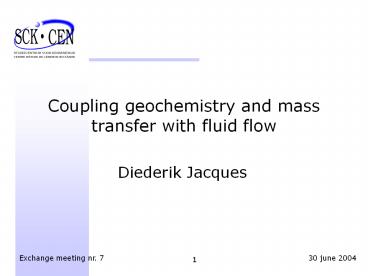Coupling geochemistry and mass transfer with fluid flow - PowerPoint PPT Presentation
1 / 22
Title:
Coupling geochemistry and mass transfer with fluid flow
Description:
Coupling geochemistry and mass transfer with fluid flow Diederik Jacques Exchange meeting nr. 7 30 june 2004 Coupled reactive transport models What? – PowerPoint PPT presentation
Number of Views:101
Avg rating:3.0/5.0
Title: Coupling geochemistry and mass transfer with fluid flow
1
Coupling geochemistry and mass transfer with
fluid flow
- Diederik Jacques
Exchange meeting nr. 7
30 june 2004
2
- Coupled reactive transport models (RTM)
- What/why/applications
- RTM contaminant hydrological models
- Example Cd leaching in a soil profile
- RTM reaction path/geochemical models
- Example alkaline fluid through Boom Clay
- Applications in deep disposal
- Conclusion
3
Coupled reactive transport models What?
- Tools to model simultaneously
- (Water flow)
- Transport of solutes and contaminants
- Biogeochemical reactions
- in porous media (geological layers / soils)
4
Coupled reactive transport models Why?
- Geochemical reactions typically occur in open
systems where fluxes drive reactions - Difficult to evaluate quantitatively the
importance of time-dependent processes without
considering them as part of a coupled system - Models can provide quantitative tests of
hypotheses
5
Coupled reactive transport modelsApplications
- Chemical weathering
- Contaminant hydrogeology / hydrogeochemistry
- Remediation design
- Assessing effects of perturbations on
geochemical conditions - Transport of radionuclides
6
Fully coupled models versus classical
contaminant hydrological models
- Ability to consider mechanistic models for
adsorption / surface complexation and their
effect on contaminant mobility - Aqueous complexation and speciation effects on
contaminant mobility - Conversion of contaminants via (bio)chemical
reactions - Dissolution/precipitation and effect on
adsorption
7
Example Cd leaching in a soil profileProblem
definition
- Podzol (Kempen) contaminated with heavy metals
(Cd, Zn, Pb) - Lysimeter (80 cm diameter, 100 cm long)
- Equipped with TDR probes
- Bottom grid based wick sampler system
- Experiment boundary conditions
- Time (d) CaCl2 (mol/l)
- 0-27.9 0.005
- 27.9-28.9 0.05
- 28.9-80 0.005
8
Example Cd leaching in a soil profileBreakthroug
h curves
9
Example Cd leaching in a soil profileEffect of
composition of inflow
10
Example Cd leaching in a soil profileUse in
safety analysis deep disposal
- Relation complexation of radionuclides mobility
of radionuclides - Including competition between complexation
reactions (RNL(aq) versus MeL(aq)) - Alternative to single Kd or retardation factor
approach for interpreting experiments - Obtaining parameters with fitting procedures
combining a geochemical model with a
calibration/fitting program
11
Fully coupled models versus reaction path /
geochemical models
- Ability to incorporate diffusive and dispersive
transport - Chemical heterogeneities easily incorporated
- Relatively easily coupled to other time-dependent
processes (e.g. heat transfer, evolving medium
properties) - Provides information on spatial distribution of
processes
12
Alkaline fluid through Boom Clay Problem
definition
- Concrete liners are required for deep disposal in
Boom Clay - (Young) Concrete water high pH, high Na and K
concentrations - Elements in concrete water will diffuse into the
Boom Clay - gt not in equilibrium with Boom Clay
- gt changing geochemical conditions in the near
field
13
Alkaline fluid through Boom ClayExperimental set
up
14
Alkaline fluid through Boom Clay Geochemical
modelling
- Inflowing solution
- pH 13.1 Na 1490 mg/l K 5500 mg/l
- Primary minerals kinetic precipitation/dissolutio
n - Illite, monmorillonite-Na, kaolinte, microcline,
quartz, albite, calcite - Secondary minerals equilibrium precipitation
- CSH-phases, zeolites, sepiolite,
- Cation exchange processes (2 approaches)
- Singlesite cation exchange without proton
exchange - Multisite cation exchange including proton
exchange
15
Alkaline fluid through Boom Clay Multisite
cation exchange complex
HY H Y- Site Log_k Ya 1.65 Yb 3.30 Yc 4.
95 Yd 6.85 Ye 9.60 Yf 12.35
16
Alkaline fluid through Boom Clay Effect of
cation exchange model
17
Alkaline fluid through Boom Clay Effect of
cation exchange model
18
Alkaline fluid through Boom Clay No secondary
K-phase
19
Alkaline fluid through Boom Clay Conclusions
- It is possible to model the experiments with
young concrete water to reproduce the main
features - However, some agreements were poor, indicating
that some mechanisms are more complicated than
the ones considered in the geochemical model
(e.g., interaction organic constituents clay
solutes)
20
Applications of reactive transport modeling in
deep geological disposal
- Which processes are determinging the transport of
RN through the Boom Clay observed during
migration experiments? - How do the geochemical conditions in different
barriers change with time and how do the barriers
interact which each other? - How far will oxygen diffuse in Boom Clay and
oxidize pyrite? - Will heat (produced from the waste) influence the
mobility of RN?
21
Available reactive transport codes at Waste and
Disposal
- Geochemist Workbench
- Crunch
- PHREEQC
- HYDRUS1D-PHREEQC
- in house coupled model
- Coupling with hydrology / water flow
- Unsaturated / transient flow conditions
- Interaction with atmosphere (precipitation /
evaporation) and plants / biosphere - Typically applications Soil
22
Conclusion / remarks
- Reactive transport modelling need a strong
interaction with pure geochemical modelling - Conceptual models
- Parameters
- Reactive transport modelling enables to model the
spatial zonation and temporal dynamics of
different geochemical domains - RN mobility

